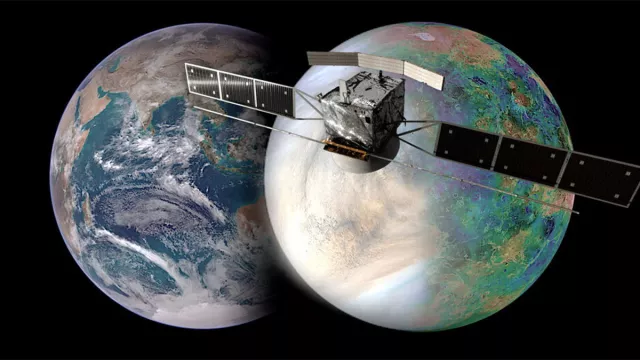EnVision is setting out to lift the veil on Venus in an attempt to understand how Earth’s “twin sister” turned into the toxic hothouse it is today.
Why, although the two planets are of similar size and composition, is the surface activity and climate on Venus and Earth so different? And what does that tell us about how Earth’s climate is likely to evolve?
Key information
| Mission | Understand why Venus, our nearest neighbour, is today so different to Earth |
|---|---|
| Domain | Science |
| Launch date | Scheduled November 2031 |
| Partners | ESA (contracting authority), CNES (funding and instruments), NASA (one instrument), IRAP, LATMOS, LIRA (ex-LESIA) and LPG (instruments), and LMD, IPAG and LTE (ex-IMCCE) (science) research laboratories |
| Where | Quasi-polar low-altitude Venus orbit (210 to 520 km) |
| Lifetime | 6-month cruise phase, 18 months of aerobraking and 4-year science mission (end of mission January 2039) |
| Status | In development |
Key figures
- 2 m x 2 m x 2 m: EnVision dimensions in stowed configuration
- 1.6 tonnes: satellite dry mass (excl. fuel)
- 4 instruments
- 8 contributing French laboratories
Key milestones
- January 2039: Planned end of mission
- December 2034: End of aerobraking phase and start of science mission
- May 2033: Arrival in the vicinity of Venus
- November 2031: Launch of EnVision mission by Ariane 62
- January 2024: EnVision mission go-ahead
- June 2021: EnVision selected by ESA
- May 2018: EnVision selected as candidate ESA medium-class (M) mission
Project in brief
The EnVision orbiter will set out to study current conditions on Venus and ascertain how the planet evolved. The mission will launch late 2031 atop an Ariane 62 from the Guiana Space Centre.
Scientists hope the mission’s data will deliver new insights into how and why Venus and Earth evolved so differently and tell us more about the formation and evolution of planets with a similar mass to our own.
Why did Venus, so similar to Earth in size and composition when it first formed, become such an inhospitable world with a runaway greenhouse effect?
The EnVision mission’s main goal is to explore Venus at different wavelengths from its core to its upper atmosphere to obtain a synoptic picture of the planet and how its layers interact. It also aims to analyse volcanic and tectonic activity and the planet’s climate by studying interactions between its atmosphere, surface and inner structure. More broadly, it will seek to gain new insights into how Earth-like planets evolve and determine the conditions required to support life.
Although Venus is our nearest neighbour, it nevertheless remains something of a mystery. Is it still active? What is its volcanic and tectonic history? What are its core and rocks made of? Was there once liquid water on its surface? What is its climate like today? And how did its atmosphere evolve?
A range of instruments and experiments will attempt to answer all these questions. Science operations will begin after an aerobraking phase in Venus’ upper atmosphere lasting 18 months before the spacecraft is placed into low-altitude polar orbit.
In summary, the mission intends to answer three main questions:
- History: How did Venus’ surface and interior evolve over time?
- Activity: Is Venus geologically active?
- Climate: How are Venus’ atmosphere and climate shaped by geologic processes?
CNES’s role
As the national space agency, CNES is overseeing all French contributions to the mission.
In particular, it is in charge of supplying the VenSpec-U spectrometer that will study interactions between the lower and upper atmosphere and the sulphur cycle, by analysing the atmosphere above the clouds, and the RadioScience experiment that will probe Venus’ inner structure.
Contacts
EnVision French Project Leader
Jérôme Carron
E-mail: jerome.carron at cnes.fr
Solar System Planets and Small Bodies subject matter expert
Francis Rocard
E-mail: francis.rocard at cnes.fr


